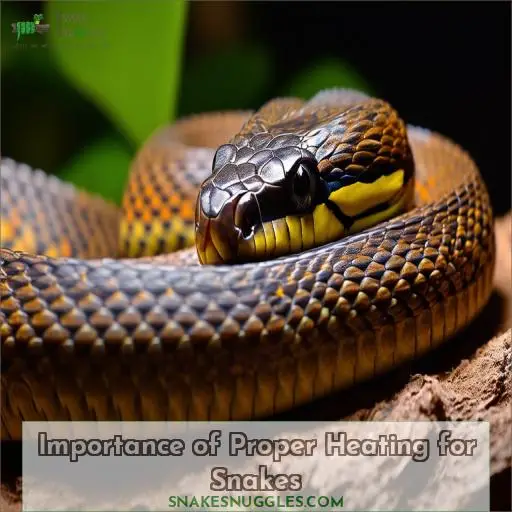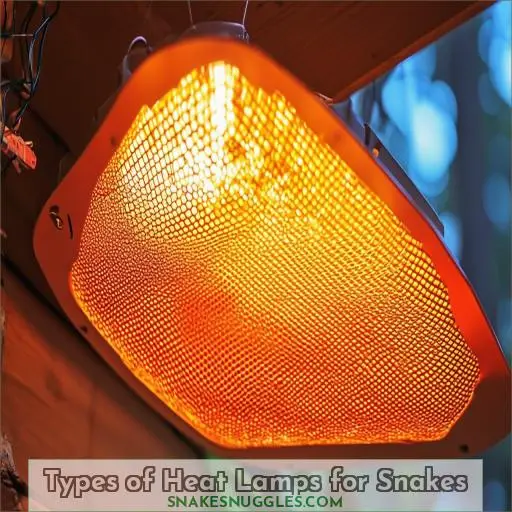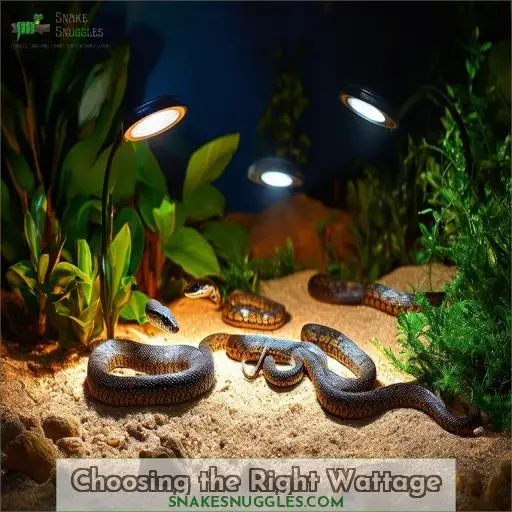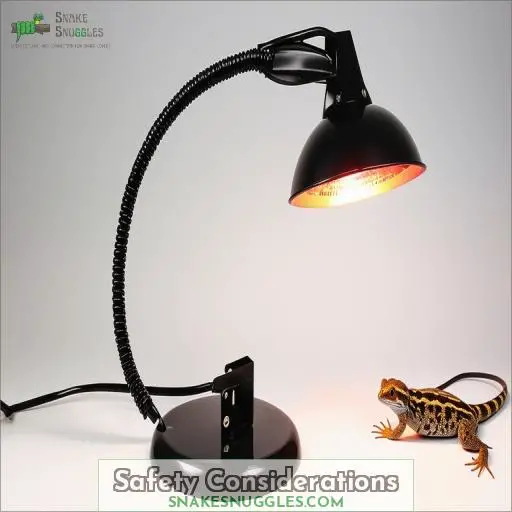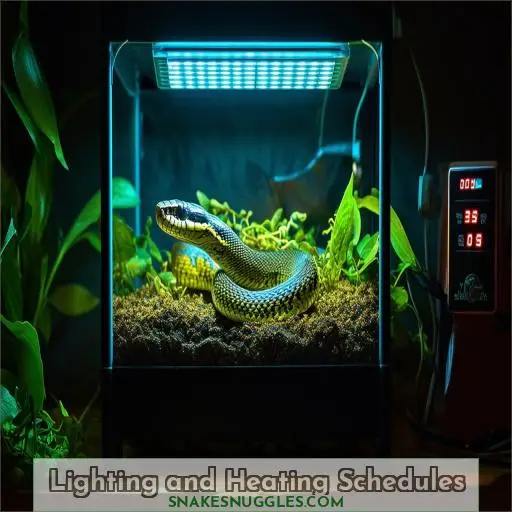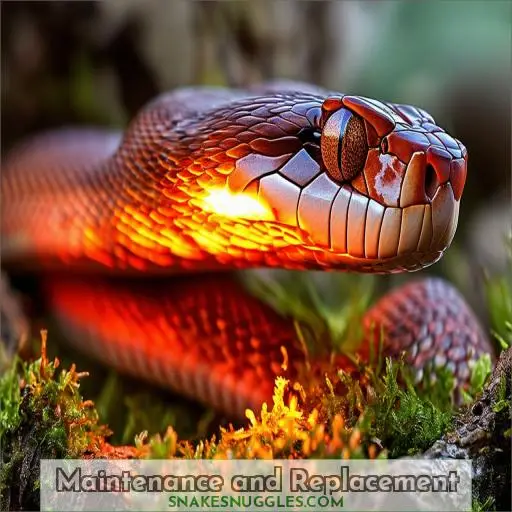This site is supported by our readers. We may earn a commission, at no cost to you, if you purchase through links.
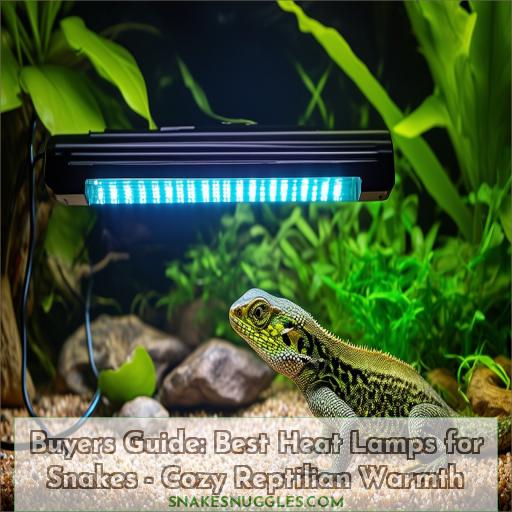 You want the best heat lamp for your snake’s enclosure, right? As a reptile owner, choosing the ideal heating setup is essential for your pet’s thermoregulation and overall health.
You want the best heat lamp for your snake’s enclosure, right? As a reptile owner, choosing the ideal heating setup is essential for your pet’s thermoregulation and overall health.
When selecting a heat lamp, consider factors like enclosure size, desired temperature range, and wattage recommendations. Ceramic heat emitters (CHEs) and radiant heat panels offer energy-efficient infrared warmth without light.
Place the heat source to create a basking spot and ambient temperature gradient. Safety is key – use a thermostat, avoid direct contact, and follow electrical precautions.
Proper heating facilitates digestion, immunity, and natural behaviors. To truly master your snake’s cozy reptilian warmth, let’s explore this buyers guide in depth.
Table Of Contents
- Key Takeaways
- Importance of Proper Heating for Snakes
- Types of Heat Lamps for Snakes
- Choosing the Right Wattage
- Proper Placement and Use
- Safety Considerations
- Lighting and Heating Schedules
- Maintenance and Replacement
- Frequently Asked Questions (FAQs)
- What type of heat lamp do snakes need?
- What is the safest heat lamp for reptiles?
- What is the best heat source for snakes?
- What wattage heat lamp for snakes?
- What is the ideal basking temperature range?
- How many heat lamps should be used?
- Can heat lamps be used with timers?
- How often should heat lamps be replaced?
- Are there any health risks from improper heating?
- Conclusion
Key Takeaways
- To strike the perfect reptilian thermal balance, you’ve got to consider your scaly sidekick’s specific heating needs like a master herpetologist. Don’t just blindly blast them with heat – every species and enclosure size has its own toasty sweet spot.
- Investing in quality heating equipment isn’t just about keeping your snake comfy – it’s a matter of health and happiness. Poor heating can mess with their digestion, immune system, and even behavior. So treat your slithery pal to the best basking spot money can buy.
- Safety first, my friend! Proper placement, thermostats, and ventilation are key to preventing any fiery mishaps or respiratory woes. No one wants a crispy critter or a surprise house fire, right?
- Just like us humans, snakes thrive on routine. Mimicking their natural day/night cycles with timed heating and lighting does wonders for their circadian rhythms and overall well-being. Who knew reptiles were such creatures of habit?
Importance of Proper Heating for Snakes
As ectothermic animals, snakes depend heavily on their environment to regulate essential bodily processes like digestion, metabolism, and immune function. Maintaining the proper heating setup is critical for your snake’s overall health and well-being, as it facilitates thermoregulation and allows for natural behaviors like basking, hunting, and shedding.
Thermoregulation and Metabolism
As cold-blooded reptiles, snakes rely on their environment to regulate body temperature and metabolism. Their infrared sensitivity allows them to detect and bask in the penetrating warmth of specialized heat lamps. Maintaining suitable temperature ranges through thermoregulatory behavior is essential for proper metabolism, enabling snakes to utilize nutrients efficiently. Body temperature monitoring with infrared heat lamps facilitates this important thermoregulation.
Digestion and Nutrient Absorption
Proper heating promotes efficient digestion by maintaining the appropriate body temperature for food breakdown. Heat lamps emit infrared rays that penetrate deeply, warming your snake’s core to facilitate nutrient absorption. With focused, localized heat distribution, specialized basking bulbs surpass standard lamps, enhancing digestion efficiency while minimizing energy usage.
Immune System Function
Proper heating isn’t just about staying warm; it’s essential for your snake’s immune health.
Inadequate temperatures weaken their defenses, leaving them prone to skin issues, respiratory infections, and other illnesses.
Heat lamps provide the cozy haven reptiles need to shed smoothly, stay hydrated, and minimize stress—the keys to a robust immune system.
Don’t skimp here; invest in quality warmth sources.
Behavioral Regulation
Proper heating helps regulate your snake’s behavior essential for their well-being. It keeps their stress response in check, balances hormones for reproductive activity, and enables natural behaviors like hibernation. With the right temperature gradient, your snake can follow its circadian rhythm seamlessly, ensuring a healthy sleep cycle and ideal mating habits.
Types of Heat Lamps for Snakes
In regards to providing appropriate heat for your snake, you have several options: incandescent bulbs offer both light and warmth, while ceramic heat emitters (CHEs) provide infrared heat without visible light. Radiant heat panels mount on the side of the enclosure to create a warm basking area, and undertank heaters slip underneath to generate ambient heat from below.
Incandescent Bulbs
If you opt for incandescent bulbs, consider energy-efficient halogen models that emit bright, concentrated heat perfect for basking areas. While inexpensive, traditional incandescents have a short lifespan and require careful thermostat regulation to prevent overheating. Make certain bulbs are sized appropriately for your enclosure and compatible with appropriate sockets for safety.
Ceramic Heat Emitters (CHEs)
Ceramic heat emitters (CHEs) are a popular choice as they radiate beneficial infrared wavelengths ideal for reptiles. With a long emitter lifespan of 2-3 years, CHEs are energy-efficient and compatible with thermostats. Mount them overhead, ensuring proper airflow, and choose a wattage suitable for your enclosure size – they’re perfect for small-to-medium habitats.
Radiant Heat Panels
Radiant heat panels provide a discrete heating solution, emitting infrared radiation to warm large areas evenly. These energy-efficient panels come in various sizes to accommodate different enclosure dimensions. They mount easily on the side or top, providing gentle heat without hotspots. The long-wavelength infrared penetrates deeply, mimicking the warming rays of the sun for ideal reptilian comfort.
Undertank Heaters
Undertank heaters are an excellent option for providing belly heat. These include:
- Heat tapes
- Heat mats
- Heat cables
- Heat rocks (though not recommended due to burn risks)
They create a thermal gradient, allowing your snake to thermoregulate by moving between warm and cool zones. Perfect for nighttime heating or creating basking spots when used with overhead lamps.
Choosing the Right Wattage
Selecting the appropriate wattage heat lamp is essential for the well-being of your snake. Factors such as enclosure size, desired temperature range, and ambient room temperature should guide your selection; for example, small enclosures typically require 25-50W lamps, medium ones 50-100W, and large enclosures 100-150W.
Factors to Consider:
When choosing a heat lamp’s wattage, consider several factors for suitable reptilian warmth. The terrarium size, desired temperature range, ambient room conditions, and species-specific lighting needs play significant roles. UVB lighting, controlled humidity, substrate selection, enclosure ventilation, and hideout design also influence the heat lamp requirements for recreating an appropriate habitat.
Enclosure Size
Enclosure size dictates your heat lamp wattage. A snug fit ensures ideal temperature gradients. Larger enclosures need higher wattage to warm air and substrate uniformly. Smaller setups might only need 25-50W. Consider the depth of substrate and dimensions for the right balance. Tailor the wattage to match the reptile’s natural habitat and activities.
Desired Temperature Range
When selecting bulb wattage for your snake’s heat lamp, consider the desired temperature range. Achieve desirable infrared radiation and heat gradients using 25-50W for small enclosures, 50-100W for medium, and 100-150W for large. Make sure the substrate temperature supports proper thermoregulation, with DHPs or deep heat projectors enhancing basking area size effectively (Source).
Ambient Room Temperature
When choosing the appropriate wattage for your snake’s enclosure, consider the ambient room temperature to guarantee the heat lamp effectively meets their heating requirements.
- Evaluate the room’s baseline temperature.
- Consider your snake’s size and species.
- Establish a proper temperature gradient within the habitat.
- Adapt for seasonal changes, using UVA bulbs like the Arcadia Solar Basking Spot or Halogen Heat Lamps for ideal warmth.
Wattage Recommendations:
When choosing the right wattage for heat lamps, consider your snake’s enclosure size, desired temperature range, and ambient room temperature. For instance, larger enclosures typically require bulbs with higher wattages to maintain an effective thermal gradient. Energy-efficient options like DHPs, or the D3 Evo Mercury Vapor Bulb, can be indispensable in balancing these needs effectively (Source).
Small Enclosures: 25-50W
For small enclosures, like those under 20 gallons, 25-50W heat lamps are ideal. Make sure proper placement to create an effective heat gradient and distribute heat evenly. Position your lamp to avoid overheating one spot, maximizing energy efficiency. Choose products tasked with providing essential UVA and UVB, while managing costs efficiently for desert-dwelling species or diurnal reptiles.
Medium Enclosures: 50-100W
For medium enclosure sizes, a 50-100W heat lamp is ideal to maintain the proper temperature gradient. Consider various options like halogen heat lamps, ceramic heat emitters, and basking spot bulbs. Each type offers unique benefits regarding energy efficiency and safety measures.
- Halogen lamps: Efficient and powerful for localized heat.
- Ceramic heaters: Great for consistent warmth.
- Basking bulbs: Ideal for reptiles needing intense heat.
Large Enclosures: 100-150W
For large enclosures (100-150W), choose heat lamps that create a temperature gradient, ensuring there’s both a hot basking spot and cooler areas. Nighttime heating needs careful consideration to mimic natural conditions without disrupting UVB requirements. Use automated cycles to regulate day-night patterns, helping your snake maintain a natural rhythm and promote overall health.
Proper Placement and Use
You’ll want to carefully position the heat lamp to create an appropriate basking spot and maintain ambient temperature for your snake’s well-being. Use a thermostat to regulate the lamp’s temperature, avoid direct contact, and always monitor the temperatures within the enclosure (Source).
Basking Spot Vs Ambient Temperature
Proper placement guarantees your snake benefits from the most effective basking spot and ambient temperature. Aim for a basking distance that promotes effective temperature regulation.
- Choose suitable infrared wavelengths.
- Consider cage size and setup.
- Install floor heating options intelligently.
- Maintain the ideal temperature range.
- Place heat sources securely, avoiding direct contact.
Thermostat Regulation
You’ll want to use a thermostat to regulate the heat lamp’s wattage precisely. Accurate temperature control prevents overheating or insufficient warmth for your snake’s wellbeing. Calibrate the thermostat to create the ideal temperature gradient:
| Cool End | Warm Middle | Basking Spot |
|---|---|---|
| 75-80°F | 82-88°F | 90-95°F |
| 24-27°C | 28-31°C | 32-35°C |
A thermostat maintains this perfect range for your reptilian friend.
Avoiding Direct Contact
You’ll want to make certain your snake can’t come into direct contact with the heat lamp. This avoids nasty burns and discomfort from:
- Hot spots
- Steep temperature gradients
- Accidental entanglement
Proper placement is key – position the lamp at a safe distance, angled to create a gentle basking area. Your scaly friend deserves a cozy, stress-free environment!
Monitoring Temperatures
To safeguard your snake’s comfort, you’ll need to monitor temperatures closely. Use multiple thermometers to measure the temperature gradient, including the basking area, warm side, and cool retreat. Check thermostat accuracy regularly and adjust as needed. Temperature fluctuations impact snake behavior, so maintaining stable, controlled environments is essential for their well-being.
Safety Considerations
When setting up heating equipment for your snake’s enclosure, burn prevention should be a top priority. You’ll need to guarantee proper installation and positioning to avoid direct contact between the snake and heat sources, as well as implement safety measures like thermostats and protective barriers to mitigate fire hazards and electrical risks.
Burn Prevention
You must prevent burns from heat lamps. Implement these precautions:
- Proper thermostat placement and settings
- Correct heat mat wattage for enclosure size
- Strategic heat lamp positioning away from animal areas
Monitor temperatures closely, and adjust equipment as needed to maintain a safe temperature gradient. Don’t overlook humidity levels; dehydration increases burn risk.
Fire Hazards
Overheating lamps can start fires, so you’ll want proper safety precautions. Keep combustibles away, use fire-proof materials for housing, and never leave heat lamps unattended. Check wiring regularly for frays or hot spots – a small spark could torch your home. Proper setup and monitoring are key to preventing reptilian warmth from becoming a house-burning blaze covered by your insurance!
Electrical Safety
While ensuring your snake’s warmth, don’t neglect electrical safety. Follow these precautions:
- Inspect wiring for frays or damage
- Use grounded outlets and surge protectors
- Avoid overloading circuits
- Secure cords away from water sources
- Unplug equipment when not in use
Electrical hazards can lead to fires or shocks, endangering both you and your scaly friend. A little caution goes a long way in keeping your reptile setup safe and sound.
Ventilation Needs
In addition to electrical safety, you’ll also need to look at ventilation needs for your snake’s enclosure. Proper airflow prevents excessive humidity and stale air buildup, which can lead to respiratory issues. Here’s a handy table to guide you:
| Enclosure Size | Ventilation Needs |
|---|---|
| Small (< 20 gal) | 2-3 air holes |
| Medium (20-40 gal) | 4-6 air holes |
| Large (> 40 gal) | Front vent screen |
Adequate ventilation, combined with appropriate substrate moisture levels and water provision, creates a healthy environment for your scaly friend.
Lighting and Heating Schedules
You must account for whether your snake is diurnal or nocturnal when establishing heating and lighting schedules. For diurnal snakes, provide higher daytime temperatures and bright lighting, while nocturnal species require warmer nights with dimmer illumination; seasonal variations may also influence heating requirements.
Diurnal Vs Nocturnal Species
Snakes are either diurnal (active during the day) or nocturnal (active at night). You’ll need to provide:
- Diurnal species: Bright basking area and temperature gradient during daylight hours
- Nocturnal species: Lower ambient temperatures, cooler basking spot, night heating
Adjusting lighting and heating schedules mimics their natural habitat and supports healthy behaviors specific to their species. Proper setups encourage natural cycles of activity, rest, and thermoregulation.
Seasonal Variations
Just as seasonal temperature changes affect wild reptiles, your snake’s heating needs will fluctuate. You’ll need to adjust nighttime and daytime heating based on habitat temperatures. For example:
| Season | Daytime | Nighttime |
|---|---|---|
| Summer | Higher | Moderate |
| Winter | Moderate | Lower |
Pay close attention to species-specific needs when making seasonal adjustments.
Automated Timers
You’ll want to invest in programmable timers to automate your snake’s heating and lighting. Reptilian circadian rhythms thrive on consistent day/night cycles, which smart timers provide. Many even offer remote access and smart home integration for effortless monitoring from anywhere. Plus, scheduled on/off times optimize energy efficiency – sparing your utility bills.
Gradual Temperature Changes
You’ll need to establish a temperature gradient that reflects your snake’s natural habitat. This guarantees they can thermoregulate appropriately:
- Set up a warm basking area around 88-95°F
- Create a cooler zone at 75-80°F for respite
- Use a thermostat to gradually adjust temps, replicating day/night cycles
Regulating temperatures gradually helps snakes adapt their circadian rhythms, conserves energy, and prevents stress from sudden fluctuations. Mimic their native climate for optimum health.
Maintenance and Replacement
To guarantee your snake’s heat lamp operates effectively, regularly clean and disinfect components to eliminate dirt, debris, and potential pathogens that could compromise hygiene and functionality. Additionally, inspect lamps, fixtures, and bulbs periodically for signs of wear or damage, replacing components as needed to maintain a safe and efficient heating setup.
Cleaning and Disinfecting
You’ll want to maintain excellent hygiene practices for your reptilian buddy’s enclosure. Sterilize equipment regularly using reptile-safe disinfectants. Swap out soiled substrate promptly, and disinfect hard surfaces. Proper cleaning prevents bacterial buildup, ensuring your scaly pal stays healthy and happy. After all, a clean home equals a content snake!
Checking for Damage
You’ll also want to regularly check your heat lamps for any signs of damage. Over time, the bulbs can crack or the fixtures can become loose, creating a fire hazard.
Inspect the bulbs for any discoloration, flickering, or decreased intensity, which could indicate it’s nearing the end of its lifespan.
Keeping an eye out for potential issues guarantees your reptile’s safety and comfort.
Replacing Worn Components
You’ll want to replace worn components to guarantee your snake’s environment remains ideal. Heat bulbs, CHEs, and heat panels have a finite lifespan, so:
- Monitor for dimming or uneven heating
- Check manufacturer recommendations for replacement schedules
- Consult reptile communities for product longevity reviews
Proactive replacement prevents dangerous hot spots and inconsistent temperatures that could jeopardize your pet’s well-being.
Upgrading Older Equipment
As your snake’s habitat evolves, you’ll want to upgrade to more energy-efficient heating equipment. Don’t just replace like-for-like; research newer models with longer lifespans and compatibility with modern thermostats. Consult reptile communities for reliable product recommendations that align with your snake’s needs. Regularly replacing aging bulbs guarantees adequate heat and UV output.
Frequently Asked Questions (FAQs)
What type of heat lamp do snakes need?
You’ll need a ceramic heat emitter or deep heat projector for your snake’s enclosure. These emit safe infrared rays that create a warm basking area without visible light, mimicking their natural environment.
What is the safest heat lamp for reptiles?
Picture your reptile basking contentedly under a ceramic heat emitter—completely safe, no burn risk. These energy-efficient bulbs radiate gentle warmth without harsh light or hot surfaces, protecting your scaly companion.
What is the best heat source for snakes?
For snakes, ceramic heat emitters (CHEs) are an excellent choice. They provide steady, radiant heat without light, mimicking the warmth of sunbaked rocks. Pair a CHE with an overhead light for a complete heating and lighting setup modified to your snake’s needs.
What wattage heat lamp for snakes?
For snakes, you’ll want a heat lamp between 50-100 watts, depending on the enclosure size and your snake’s specific heating needs. Larger enclosures or warm-climate species require higher wattages, while smaller setups may only need 50 watts. Always use a thermostat to regulate temperatures safely.
What is the ideal basking temperature range?
For ideal health, you’ll want to maintain a basking temperature between 88-95°F (31-35°C) on the warm side, with a cooler area around 75-80°F (24-27°C). Carefully monitor temperatures with reliable thermometers.
How many heat lamps should be used?
For a medium-sized snake enclosure, two heat lamps provide the ideal temperature gradient – one for basking at around 90°F, and another on the cool end near 75°F. Larger enclosures may require more lamps to establish proper thermal zones.
Can heat lamps be used with timers?
Yes, you can absolutely use heat lamps with timers. It’s recommended to time the lamps to simulate natural day/night cycles, promoting healthy circadian rhythms for your reptile.
How often should heat lamps be replaced?
To paint a clearer picture, heat lamps should typically be replaced every 6-12 months. Their intensity gradually diminishes, so regular replacement guarantees your reptile receives proper warmth and light for adequate health and comfort.
Are there any health risks from improper heating?
Improper heating poses severe health risks for reptiles. Inadequate temperatures can induce digestive problems, respiratory infections, lethargy, and organ failure. Maintaining suitable heat gradients aligned with species-specific requirements is paramount for your pet’s well-being.
Conclusion
Ultimately, the quest for the best heat lamp for snakes is an investment in your reptilian companion’s comfort and well-being.
By understanding thermoregulation needs, wattage requirements, and safety protocols, you’ll create a cozy basking spot that mimics their natural habitat.
This buyers guide equips you with the knowledge to make an informed choice, ensuring your scaly friend thrives in a perfectly heated enclosure.
Master the art of reptilian warmth, and witness your snake’s vibrant behavior and health flourish.

